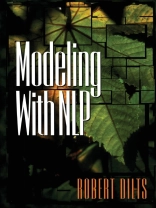Thomas Jefferson once said, “If two individuals get together and exchange a dollar, they each walk away with one dollar. If the same individuals get together and exchange an idea, they both walk away with two ideas.” In many ways, this statement expresses the vastly generative potential or “economics” of modeling.
Modeling is the process of taking a complex event or phenomenon and breaking it into small enough chunks so that it can be recapitulated or applied in some way. Behavioral modeling involves observing and mapping the successful processes which underlie an exceptional performance of some type. The purpose of behavior modeling is to create a pragmatic map or ‘model’ of a particular behavior which can be used to reproduce or simulate some aspect of that performance by anyone who is motivated to do so.
The ability to model effectively opens the door to many possibilities that have previously been unavailable to humankind. In addition to providing a methodology which can be used to make ideas more explicit and easier to communicate, modeling can transform the way we view and perceive one another. If we see someone who does something better than ourselves, for example, instead of looking at that person and feeling inadequate, jealous, or suspicious, we can go out and model how they do what they do. Then, we too can have the capability that the other person possesses.
The field of Neuro-Linguistic Programming (NLP) has developed out of the modeling of the behaviors and thinking processes of exceptional people from many fields. NLP modeling procedures involve finding out about the mental strategies (“Neuro”) a person is using by analyzing that person’s language patterns (“Linguistic”) and non-verbal responses. The results of this analysis are then put into step-by-step strategies or procedures (“Programming”) that may be used to transfer the skill to other people, and apply it to other contexts. The purpose of NLP modeling is to put what ha with which to identify and describe specific, reproducible patterns in the language and behavior of effective role models. The purpose of NLP modeling is to put what has been observed and described into action in a way that is productive and enriching. In fact, the worldwide success of NLP as a technology for creating and managing change comes from its foundation in the modeling process.
This book is about the NLP modeling process and its applications. The first part of this book is devoted to defining the principles and tools necessary for effective modeling (the “epistemology, ” methodology and technology of NLP). The second part of the book illustrates the application of NLP modeling procedures to the study of effective leadership. It provides examples of how NLP was applied to identify specific cognitive, linguistic and behavioral skills used by leaders to address challenging situations involving problem solving, delegation and training on the job. The results define the key communication and relational skills employed by effective leaders to achieve practical results in their working reality, in order to “create a world to which people want to belong.
Over de auteur
Robert Dilts has had a global reputation as a leading behavioral skills trainer and business consultant since the late 1970s. A major developer and expert in the field of Neuro-Linguistic Programming (NLP), Robert has provided coaching, consulting and training throughout the world to a wide variety of individuals and organizations.
Past corporate clients and sponsors have included Apple Inc., Microsoft, Hewlett-Packard, IBM, The Old Mutual, Société Générale, Bank of America, The World Bank, Alitalia, Telecom Italia, RAI Italia, Lucasfilms Ltd., Ernst & Young, AT Kearney, Salomon, The American Society for Training and Development, EDHEC Business School and the State Railway of Italy. He has lectured extensively on coaching, leadership, organizational learning and change management, making presentations and keynote addresses for The International Coaching Federation (ICF), HEC Paris, The United Nations, The European Forum for Quality Management, The World Health Organization, The Milton H. Erickson Foundation, Harvard University and the International University of Monaco. In 1997 and 1998, Robert supervised the design of Tools for Living, the behavior management portion of the program currently used by Weight Watcher’s International.
Robert was an associate professor at the ISVOR Fiat School of Management for more than fifteen years, helping to develop programs on leadership, innovation, values and systemic thinking. From 2001-2004 he served as chief scientist and Chairman of the Board for ISVOR DILTS Leadership Systems, a joint venture with ISVOR Fiat (the corporate university of the Fiat Group) that delivered a wide range of innovative leadership development programs to large corporations on a global scale.
A co-founder of Dilts Strategy Group, Robert was also founder and CEO of Behavioral Engineering, a company that developed computer software and hardware applications emphasizing learning strategies and behavioral change. He is also co-founder, with Dr. Stephen Gilligan, of the IAGC (International Association for Generative Change). Robert has a degree in Behavioral Technology from the University of California at Santa Cruz.












